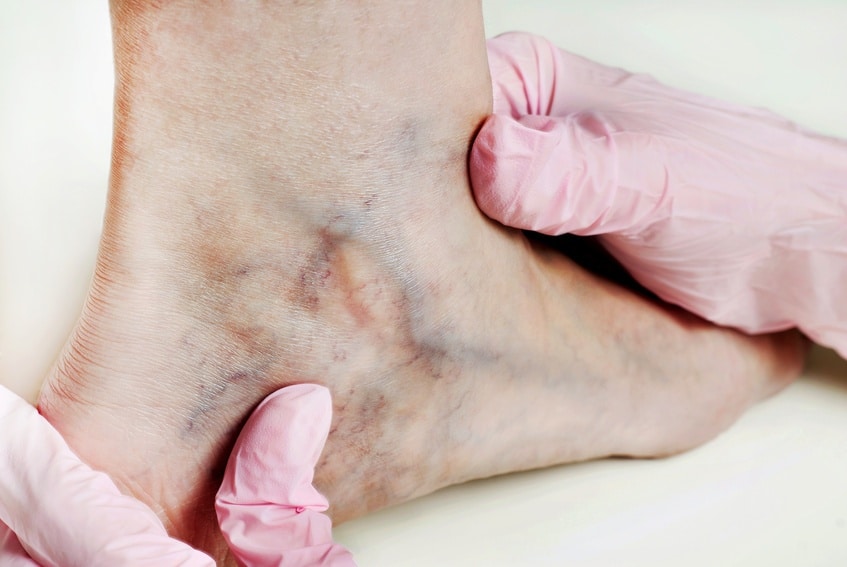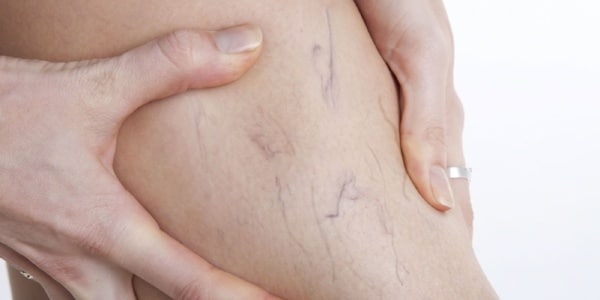Spider Veins Symptoms, Causes, and Treatment
Also known as telangiectasia, are small veins located just under the surface of the skin.
What are Spider Veins?
Spider veins, also known as telangiectasia, are a group of dilated veins located just under the surface of the skin and most often found on the legs. Usually red or blue in color, they resemble spider webs or tree branches. While smaller than varicose veins, spider veins share some common characteristics with varicose veins in terms of causes and symptoms.
While sometimes a cosmetic issue, more often than not, there is an underlying venous disease that is of greater concern. These spider veins on legs can sometimes be painful, burn, itch or, in the worst instances, rupture and cause bleeding. For these reasons it is always best to have a Vein Specialist diagnose varicose veins or spider veins in order to rule out these larger issues. Insurance will typically cover treatment if you have painful spider veins if they affect your activities of daily living.
There are a lot of myths and misconceptions when it comes to spider veins.
Myth #1: Spider Veins are Only Cosmetic
Many people believe that spider veins are unsightly but do not require treatment. Often times, there is
[read more="Click here to Read More" less="Read Less"] underlying venous disease that is a much greater issue.
Myth #2: Spider Veins are Just Part of Getting Older
Although age is one of the risk factors of varicose and spider veins, it’s not the only one and is definitely not the most frequent one. The primary cause of any vein disease is hereditary. In other words, ladies and gentleman, if your mom or grandmother had varicose or spider veins, you are more likely to have them and your age is no longer relevant. In fact, vein disease can start to develop as early as your 20's, and if left untreated, varicose and spider veins will be a natural consequence. Other risk factors include female gender, pregnancy, sedentary lifestyle, being overweight, and having a history of prior leg trauma.
Myth #3: Spider Veins are Strictly a Problem for Women
Incorrect! Spider veins can happen to anyone. It is estimated that as many as 45% of all men will develop some form of venous disease by the time they reach their 60s. The number one cause of varicose veins in both men and women is family history. Lifestyle factors play a significant role as well. If your occupation requires you to stand for long periods, such as medical professionals, factory workers, first responders, sales or restaurant staff, you are more likely to get varicose veins. If you travel and spend long hours flying or driving, or if you sit at a desk for several hours at a time, you are at high risk as well.
Myth #4: Running or Standing Can Cause Spider Veins
Again, this is incorrect. In fact, running, walking or exercise is good for your veins and helps increase circulation. Prolonged standing and sitting in one position does aggravate venous disease and you will notice it more.
Myth #5: Only Overweight People get Spider Veins
Although weight may be a risk factor, a 2015 research article published in Phlebology could not directly link obesity with vein disease, so we can’t really bust that myth. Maintaining a healthy weight and lifestyle can help ease symptoms.
Myth #6: Surgery is the Only Option to Treat Spider Vein Pain
Treatments for venous disease have taken huge leaps forward. Today, there is a range of minimally invasive, maximally effective procedures that can have you back on your feet with a much improved quality of life in very little time. Many of these procedures can be performed in a clinic, on an out-patient basis, with local anesthetic. More often than not, spider veins are treated with non-invasive or minimally invasive techniques that are nearly pain-free.
Myth #7: Vein Treatment is Painful
There was a time when leg vein surgery only referred to procedures such as vein stripping and ligations, painful procedures, likely involving general anesthetic, and definitely involving long and difficult recovery times. There are several modern procedures for varicose veins, spider veins, venous insufficiency and other vascular disease, which, cause minimal pain (if any) and have very fast recovery times. Watch this video from Jilanne Rose, DNP-C to learn more about what you can expect in terms of pain and recovery time.
Myth #8: Vein Treatment is Expensive and Not Covered by Insurance
Many people mistakenly believe that varicose and spider veins are only a cosmetic issue. In reality, the majority of our patients, typically have complaints that indicate an underlying venous condition such as leg pain and/or swelling, restless legs or numbing, tired legs, and leg ulcers. These are real medical problems that significantly impair activities of daily living.
After a full vein exam and ultrasound, patients find that commercial insurance carriers almost always cover vein treatment. Medicare and AHCCCS will also cover vein treatment.
Additionally, the latest techniques in Sclerotherapy and Thermal Ablation, are minimally invasive and the costs are considerably lower than what you previously had to pay for a surgery.
It is best to get a complete vein exam and consultation from a qualified vein specialist in order to fully understand your specific circumstances. If you would like to find out if you are at risk of venous insufficiency in the Scottsdale, Phoenix, Mesa or Tempe area, click on the link to the right to book an appointment.[/read]

Patient Testimonial
"I can't explain what Jilanne has done but changed my life on many ways. She knows her stuff and makes you feel very confident in her expertise and I don't ever second guess her. I will never trust any one but her. I feel I look amazing because she so honest and conservative. She is the best!"
Tammie M.
Advanced Vein Institute Patient
Spider Vein Symptoms
Spider veins are easily recognizable by their web-like or "tree branch" appearance and sometimes do not cause pain, however, the following symptoms are often present as well:
- Aching legs
- Painful legs
- Burning or Itching
- Swelling Legs
- Rash
- Bleeding Veins
- Skin Ulcers
Often patients find the cosmetic appearance of spider veins distressing and that is reason enough to seek treatment. In these cases, insurance is not going to cover the treatment and we provide reasonable costs for sclerotherapy.

Spider Vein Picture

The easiest way to picture the venous system is like branches of a tree. The veins you cannot see are the larger branches, and the spider veins are like the leaves.
What Cause Spider Veins?
 Spider veins in legs and varicose veins have similar causes. Normal veins have one-way valves that prevent blood from flowing in reverse as your body pumps blood back to the heart. When these valves cease to function properly, blood is allowed to collect, or pool, and the vein swells.
Spider veins in legs and varicose veins have similar causes. Normal veins have one-way valves that prevent blood from flowing in reverse as your body pumps blood back to the heart. When these valves cease to function properly, blood is allowed to collect, or pool, and the vein swells.
The following are found to be the most common causes of spider veins:
- Aging - As we age, veins become weaker due to loss of elasticity.
- Pregnancy - In order to support a growing fetus, the volume of blood in the body increases during pregnancy but blood flow from legs to pelvis decreases.
- Heredity – Family History of Varicose or Spider Veins.
- Standing or Sitting for long periods - Blood does not flow well without body activity.
- Obesity - Additional weight puts additional pressure on veins in the legs.
- History of Blood Clots
- Use of Birth Control Pills
Cosmetic or Not?

Sometimes these spider veins can be successfully treated cosmetically with surface laser or sclerotherapy, however, if a larger vein problem exists, these types of treatments will either fail completely, or only work for a short period of time.
Spider Vein Treatment
The procedure for spider vein treatment has a fast recovery time. The treatment options we employ at Advanced Vein Institute of Arizona are:
- Sclerotherapy (chemical injection)- Sclerotherapy can be used to treat telangiectasias, small varicose veins, and reticular veins. This can be a time and cost effective procedure but sometimes requires multiple sessions for complete successful removal. Occasionally spider vein treatment is performed with ultrasound guidance. In spite of improved laser technology, sclerotherapy remains the treatment of choice for lower extremity spider veins, reticular veins, and small varicose veins. Laser therapy for spider veins is typically more expensive and less effective. A 2015 study noted that laser treatment is associated with more pain than sclerotherapy and sclerotherapy can also treat the feeder veins.
- [popup_trigger id="1655"]Cost of Sclerotherapy- Spider veins removal cost is based on how many syringes are needed and how many locations we are treating. In addition, if you are symptomatic, such as treating veins that have hemorrhaged, your insurance may cover the treatment. Click for current pricing.[/popup_trigger]
- Contraindications -Sclerotherapy should not be performed in patients who have signs of acute thrombosis / phlebitis,due to the increased risk of DVT. Also, pregnant women should defer treatment until after delivery.
- Cosmetic Laser Surgery- We are proud to offer the Alma Harmony Laser for spider veins, facial feins, and small varicose veins.
Next Steps for Vein Evaluation
![AdobeStock_124052634_Preview-104244-edited[1] AdobeStock_124052634_Preview-104244-edited[1]](https://advancedveinaz.com/wp-content/uploads/2018/10/AdobeStock_124052634_Preview-104244-edited1-300x200.jpeg)
Now you know what causes spider veins and we believe that every patient's situation is unique, and every varicose and spider vein treatment should be specifically tailored for each patient. Both varicose and spider veins should be fully diagnosed in order to rule out any larger, more complex issues like Chronic Venous Insufficiency (CVI) or Venous Reflux Disease. We perform an exam and duplex ultrasound to enable us to properly diagnose and recommend the best treatment for spider veins.
Are you ready to get started?
Not quite sure yet?
Why not read what other patients have to say about their experience, we love to share feedback!
